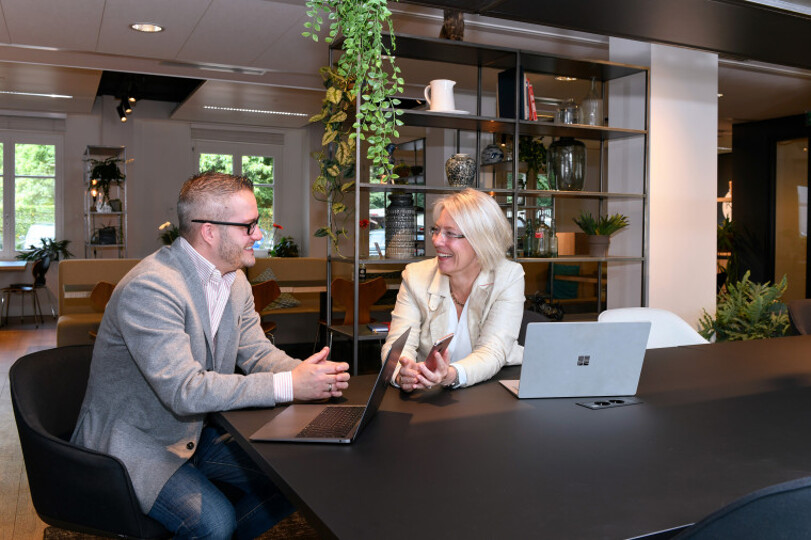The renewed HR cycle: feedback is a gift
The traditional HR-cycle
Feedback: focus on strengths, not on weaknesses
The traditional way of giving feedback mainly focuses on people's points for attention and development, rather than on their qualities. Next, the focus is on how people can meet the organisation's standards. Shortcomings are therefore often seen as the greatest potential for growth. Those who are not familiar with a employee's particular situation may suggest to follow a certain course to develop lesser strengths so that the employee can better fit their respective position. However, this proposal and proposals like them are often met with resistance. This is a logical consequence, as we humans want to change but not be changed. We want to have autonomy and determine and realise the development ourselves.
The assumption from traditional performance management that people are motivated to improve themselves when they receive feedback on their shortcomings is therefore incorrect. As much as you want to tell someone that they're making a mess, ultimately it's about letting the other person learn and grow from feedback. This means that feedback must meet certain criteria. Employees, on the other hand, like to receive constructive feedback in order to develop. It is important to know what feedback you give and to understand which (psychological) mechanisms are behind giving and receiving feedback, mechanisms which we are often not even aware of. For example, we will perform better if the focus is on our strengths and how we can use them to grow. If the focus is only on negative aspects, we will perform less well. Our brain has many tricks to deceive ourselves so that we don't have to take in negative information. The way of giving feedback is therefore very decisive, but the recipient also has work to do themselves.
Feedback begins with self-reflection
One of the shortcuts we make is that we often project onto each other during the feedback process. You look in the mirror, only you don't see the other person, but rather yourself! This makes you project feelings, qualities, or hidden wishes onto others. That is why it is important to ask yourself what intention you have when giving feedback and whether the feedback is really about the other person, or rather about yourself. Are you telling it because you want the other person to know that their behavior evokes something with you, and you tell them this in order for them to learn and grow? Only then can we talk about giving feedback. However, it also often happens that people find something the other person does irritating and present it as feedback with the underlying idea that the other person needs to adjust his or her behavior. A simple question like “what do you expect from me?” is a good way to find out whether the feedback is intended to be projection or feedback.
We must start with self-reflection and self-awareness in order to grow. Self-reflection starts with looking at yourself and asking for feedback in order to gain more insight into yourself and to grow from it. This is essential for developing a learning attitude. Hold up a mirror to yourself and reflect on who you are, what you do, and how you do it. Only then can you give feedback with the right intention.
Stimulate feedback, motivate employees
Constructive feedback gives employees more insight into the qualities that enable them to perform optimally. This gives them more confidence in their own competences. Employees develop a good self-image of personal talents and qualities, so they can therefore make maximum use of them. Working from strengths then leads to more enthusiasm, more self-confidence, better performance, and less absenteeism. The result: people set higher goals for themselves, work harder, and collaborate more to achieve goals.
People who feel competent and confident are often intrinsically motivated to develop themselves further. They are more likely to be optimistic about the future and their development potential, which leads them to set more challenging goals and adopt different strategies to achieve their goals. When faced with setbacks, they persevere instead of worrying about shortcomings. They are also more likely to ask for help. This way, you get employees who are innovative, help each other, and explore new possibilities!
Feedforward: look torwards the future, not the past
Feedforward is therefore even better. The focus is not on what the employee did not do well in the past, but what they can do differently in the future. It is about what and how the employee wants to develop themself, so that the employee has maximum influence (self-direction) and many more options to be more successful in the future. This gives energy and positive signals to the brain, which triggers action. This is why feedforward fits in so well with the renewed HR-cycle.
Spiegelapp, our interactive talent development tool, ensures that this forward-looking feedback can be requested and given at any time, thus triggering continuous talent development. This not only leads to more enthusiasm, job satisfaction, and productivity, but also to higher customer satisfaction.
Stimulate working from strength
